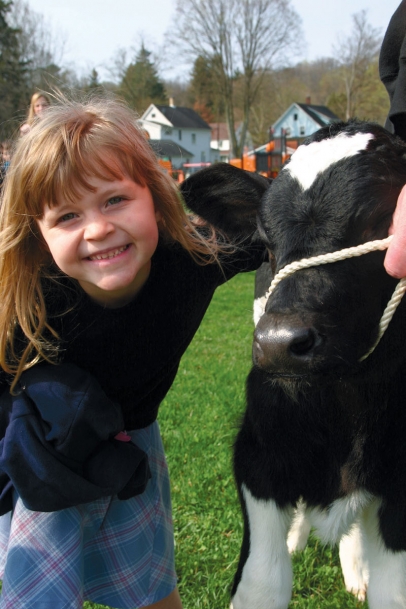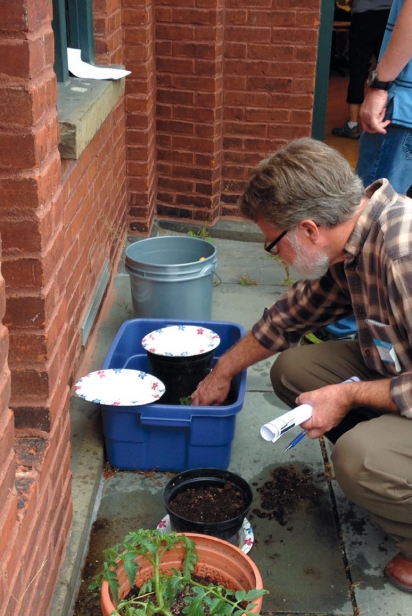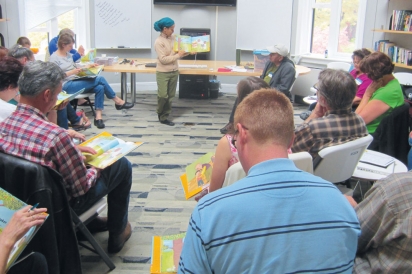Ag In The Classroom
Digging Up America’s Roots
Agriculture is America’s culture.
The roots of our nation were planted in farmers’ fields hundreds of years ago and from those humble seeds, we have harvested a rich, complex socio-economic feast in which it seems that anything is possible, and anyone can be anything.
The results, not to mention the decidedly undemocratic manner in which our democracy was achieved, are far from perfect. So while it seems like any career is within reach—from astrophysics to zoology—the career path common to our forefathers is out of reach for most Americans. As the country blossomed, we got far away from our roots, and our relationship with food and farming has become so warped that our health suffers. Rates of obesity have doubled in children and quadrupled in adolescents in the past three decades. The problem is literally dead serious.
“Less than 2% of Americans work as farmers,” Katie Sue Bigness, director of New York Agriculture in the Classroom, tells Edible. “Most students in our classrooms are at least four generations removed from the farm. That’s a lot. But almost 20% of the nation’s workforce is involved in agriculture in some way—through sales, distribution, processing or marketing.”
And 100% of us have to eat, every day. Our daily acts of agriculture are often more connected with factories and processing plants than they are with farms though especially for children.
In America, we spend about $150 billion a year treating diseases that are directly linked to the food we eat. According to the Centers for Disease Control, Americans eat fruit 1.1 times per day and vegetables 1.6 times per day. Kids spend the vast majority of their time in school, and unless cafeterias increase access to real fruits and vegetables and decrease access to junk, the trend of children getting most of those paltry servings of fruit and veggies per day will come in the form of tomato sauce on pizza and fried potatoes in Tater Tots.
Ag in the Classroom was founded to close the chasm between the average child and the farm. Not only do children often fail to understand where their food comes from, they—perhaps more distressingly—have no real understanding of the farm’s role in our history as a nation and their place in it.
“It is essential to help students understand where food comes from,” Bigness explains. “We want to make sure that students, who are current and future consumers, are making the most well-informed choices they can for themselves, their health and their communities. We want them to understand what a Community Supported Agriculture (CSA) is, to break down the barriers between farmers, students and grocery stores. We want them to be able to ask questions and feel confident.”
Ag in the Classroom was created 30 years ago, as a partnership between Cornell University, the NYS Education Department, the NYS Department of Agriculture and Markets, the Cornell Cooperative Extension and the New York Farm Bureau. Ag in the Classroom’s mandate is vast: “to foster awareness, understanding, and appreciation of how we produce food and fiber, what we eat, and how we live, by helping educators, students and their communities learn about and engage with agriculture and food systems.”
No pressure! Just the future of local foodways, our children, their health and the bucolic landscape we cherish at stake here.
Despite being continually funded and operational for 30 years, Ag in the Classroom still feels grassroots and exudes the kind of energy that decades of bureaucracy almost always manages to strangle with an endlessly unspooling ribbon of red tape.
Getting healthier, locally produced farm-fresh food into the schools has become marginally easier with federal legislation in 2008, and then came the USDA’s creation of the Farm to School program in 2010. In the late 1990s, just a handful of farm-to-school programs existed, and now they’re in more than 10,000 schools in every state. According to a recent report from the USDA, 36% of schools are serving local foods and 9% of the remaining 64% plan to incorporate local food “soon.”
Overhauling the country’s school nutrition system is a thankless task that entails getting several different entities—producers, buyers, food directors, principals, parents and teachers—to work together. And while getting mom-and-pop farm spinach on children’s plates is half the battle, the other half—getting them to eat it, which in many ways is Ag in the Classroom’s mission—is arguably, much more difficult.
Ag’s still-intact halo of idealism and its surprisingly high rates of success are due in part to the zeitgeist (“we are in a foodie Renaissance!” Bigness acknowledges), but is primarily due to Bigness’ enthusiasm, as infectious as a case of the giggles at a second grader’s birthday party.
That enthusiasm must come in handy, because despite the size of the program, which spans the entire state, she’s pretty much a one-woman show.
“I have the best job in the whole world,” she says. “I work with teachers and farmers every day. I train about 250 teachers every year in a curriculum that links food, land and people, while still fulfilling state and federal learning standards.”
Bigness developed an Agricultural Literacy Curriculum Matrix for pre-K-12 teachers, with 55 lessons plans. It is available and searchable online, smoothly linking food, agriculture, land and people to the teachers’ mandatory lesson plans in science, math, social studies and English classes.
Theory is great. Inserting data points is an essential component in Ag’s overall vision of re-linking New York students to the land. But the best way, Bigness believes, is by having the children actually interact with farmers, the land, plants and animals in person. Life happens in the fields.
“Experiential learning has a huge impact on students,” Bigness asserts. “Seeing, touching and doing is essential to drive home a broader message about their relationship to and historical roots in agriculture. We bring as many farmers to classrooms as we possibly can, and we started organizing garden programs in classrooms way before it was cool—in 1998. We also push field trips to farms. If students are allocated two field trips per year, we try to make sure that they end up on a farm for one of them.”
In the Capital District, thanks to a host of dedicated educators, farmers and volunteers, local students are being empowered to think about food systems in a completely new way.
“Teachers and schools in the Capital Region are vibrant, enthusiastic proponents of Ag,” Bigness said. “I’ve seen teachers incorporate the lesson plans in such creative ways and it’s completely inspiring. Colony collapse disorder gets integrated into math and social studies. The birth and spread of civilization in the Mayan and Aztec worlds is illustrated through their use of aquifers and aqueducts—and then brought back to modern farming and home-gardening techniques that are actually very similar. Once students can relate to Mayans in a tangible, practical way, their understanding of their impact on the world deepens.”
In addition to offering training for teachers who want to bring more Ag into their classroom, the organization offers various mini-grants, stipends, training programs and contests.
And then there’s Agricultural Literacy Week, which is also celebrating an anniversary this year. Volunteers go into participating classrooms to read a New York-themed agricultural book—one gets chosen every year for the entire state—and then participate in hands-on lessons and activities. In celebration of its 10th year, participants read Weaving the Rainbow by George Ella Lyon this spring. The book tells the tale of one girl who raises and cares for sheep and then uses their fleece as her medium in woven artwork. Students learned the steps of shearing, carding, spinning and dying fiber-producing animals, including sheep, goats, alpacas and rabbits, and reflected on their role in New York’s agricultural industry. Every year, the program selects a book that highlights a different area of agriculture, and many of the authors participate in the program themselves, Bigness says.
The program has been a runaway success, even in schools that have resisted Ag’s other offerings. “Just five years ago our goal was to purchase maybe 1,000 books to send to schools in the area,” Bigness said. “Now, we’re purchasing more than 2,000 books. In 2012 we read to 37,000 students and this year we read to more than 51,000. The program is in 2,700 classrooms and more than 200 volunteers help read to the children, talk about the broader implications of the subject matter and create hands-on projects that incorporate the subject matter.”
In many ways, Literacy Week is the Ag gateway drug. Every county in the Capital Region has an education coordinator who works with Cornell and teachers who want to implement the program, and Literacy Week often becomes the entry point for Ag in the Classroom in general.
“Every year we try to work with more schools and more teachers, and currently we read to first- through third-grade students at 30 elementary schools that are part of 13 different public school districts or private schools in our county,” explains Katie Donnan, the Pro-Ed Chairperson for Saratoga County Farm Bureau, who works with Julie Curren at Saratoga County Cooperative Extension to coordinate the Ag in the Classroom program in Saratoga County Elementary Schools. “Our mission is to foster long-lasting relationships with teachers and schools so that we are able to teach youth about agriculture year after year.”
The relationships Donnan has helped foster have flourished. For example in the Galway Central School District, National Honor Society high school students have started partnering with second-grade teachers at the elementary school to mentor younger children, she says.
“The students enjoy working with the older students from the high school, and these students also gain from this mentor experience,” Donnan explains. “In addition to exposing students to agriculture, high school students take on a mentoring role, and a connection between science, technology, engineering and math and agriculture has been made.”
Developing school gardens has also been a coup for the Ag program. Since 1998, the program has funded more than 500 gardens. Teachers in the Capital Region have embraced it, Bigness says. Some schools have mini-gardens in the classroom, some teachers focus on aquaponics where plants and fish feed each other, while others use the intricacies of the construction itself as an excuse to flex math muscles.
“Gardens, more than any of our programs, really depend on the teacher to succeed,” Bigness says. “I’ve seen teachers who get their students to incorporate sophisticated math problems in planning and graphing the angles of boxes and sizes of beds. Some teachers turn the garden into the launching pad for months of lessons. One teacher in Buffalo had her students, 95% of whom speak English as their second language by the way, plant vegetables and fruits from their home countries, do presentations on the food and country, and then at harvest time, bring it home as a gift for their parents. Some of the parents said they hadn’t tasted the vegetables their kids grew in years.”
The teacher’s imagination is the only thing limiting Ag in the Classroom’s program. Students in the Capital Region appear to be blessed with enthusiastic teachers, coordinators and volunteers.
“We’ve had such a wonderful time with the Ag Literacy Program,” 4-H Issue Leader for Albany County, Barbara Eastman Stevens, says. “We even had a 4-H alum from SUNY Cobleskill [Rachel Lee] be a guest reader at Voorheesville Elementary School. She is studying animal science and is in charge of 35 sheep at the college so she was able to talk to the youth about carding wool and the science behind making the marble. Because of her 4-H background, Rachel was so comfortable with the kids and did a terrific job. In the past, we’ve also had Albany County District Attorney David Soares read to the youth, and this past year, we had former NYS Senator Cecilia Tkaczyk of the 46th district read to the youth and she brought a lamb into the classrooms at Delaware Community School. She raises sheep so she also spoke to the students about caring for sheep and how to work with wool.”
Stevens continues, “Last year, the book, Growing Your Own Soup, was such a hit with our volunteer Master Gardener program here in Albany County that they decided to take the ‘show on the road’ and use the book and the topic of growing a vegetable garden to educate youth in public libraries and after-school programs about the importance of growing their own food. The Ag Literacy Program has made a huge difference in teaching students across Albany County and New York State about a variety of topics related to agriculture. Students learn where their food comes from, where their clothing comes from, and how important it is to support local agriculture right in their own backyard.”
It took several generations to remove American life from the farm. In the process, our understanding of agriculture, society, history and basic nutrition plummeted, the results of which are registered daily in grim statistics about children’s faltering health and academic success. Thanks to Bigness, the farmers in our region, and some of the Capital Region’s amazing teachers, our students are getting an opportunity to discover (and eat) their roots.
Programs and Stats
• 51,000 students participated in Agricultural Literacy Week (ALW) this year.
• 2,700 classrooms had programs for ALW.
• Every county in NYS participated.
• 500-plus school gardens funded since 1998.
• $40,000 investment in school gardens ($500 per garden) so far.
• Between 1998 and 2012, Albany County received eight Kids Growing School Garden Grant Awards, Rensselaer received two, Saratoga received one and Schenectady received four.
• Mini-Grants for Teachers & Schools: Kids Growing Food and Agricultural Awareness mini-grants support school food gardens and other activities that boost agricultural literacy and enhance student learning.
• Agricultural Literacy Week: During a week every March, volunteers throughout the state read an agriculturally themed book to second-grade students and lead a hands-on activity. Teachers receive instructional resources and the book is donated to the school’s library.
• I Heart NY Agriculture Contest: Students explore where food comes from and the importance of agriculture to New York communities in this annual art and writing contest.
• Educator Workshops & Webinars: Professional development for pre-service and in-service teachers, Cooperative Extension and other community educators, partners and volunteers on integrating agricultural literacy into curriculum.
• Empire Educator e-Newsletter: Monthly resource for teachers, community partners and volunteers who facilitate agricultural literacy at the local level.
Ways to help
Tell your favorite teacher about an upcoming Ag training session on September 18–19 at the New York Farm Bureau office in Albany. Scholarships are available.
Get an Ag License plate. In 2003, Lt. Gov. Mary Donohue, along with State Agriculture Commissioner Nathan L. Rudgers and State Commissioner of Motor Vehicles Raymond P. Martinez, unveiled New York’s “Ag Tag” custom license plate, the proceeds from which will benefit the New York Agriculture in the Classroom Program. Available through the DMV.
Volunteer to read at next year’s Agricultural Literacy Week.






